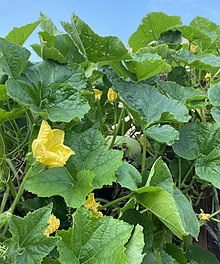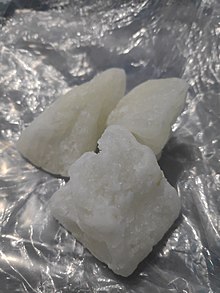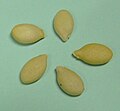Wax gourd
| Wax gourd | |
|---|---|

| |
| Wax gourd plant, flower and immature and mature fruit | |
| Scientific classification | |
| Kingdom: | Plantae |
| Clade: | Tracheophytes |
| Clade: | Angiosperms |
| Clade: | Eudicots |
| Clade: | Rosids |
| Order: | Cucurbitales |
| Family: | Cucurbitaceae |
| Genus: | Benincasa |
| Species: | B. hispida
|
| Binomial name | |
| Benincasa hispida (Thunb.) Cogn.
| |
| Synonyms[1] | |
|
List
| |
| Nutritional value per 100 g (3.5 oz) | |||||||||||||||||||||||||||||||||||||||||||
|---|---|---|---|---|---|---|---|---|---|---|---|---|---|---|---|---|---|---|---|---|---|---|---|---|---|---|---|---|---|---|---|---|---|---|---|---|---|---|---|---|---|---|---|
| Energy | 54 kJ (13 kcal) | ||||||||||||||||||||||||||||||||||||||||||
3 g | |||||||||||||||||||||||||||||||||||||||||||
| Dietary fiber | 2.9 g | ||||||||||||||||||||||||||||||||||||||||||
0.2 g | |||||||||||||||||||||||||||||||||||||||||||
0.4 g | |||||||||||||||||||||||||||||||||||||||||||
| |||||||||||||||||||||||||||||||||||||||||||
| Other constituents | Quantity | ||||||||||||||||||||||||||||||||||||||||||
| Water | 96.1 g | ||||||||||||||||||||||||||||||||||||||||||
Link to USDA Database entry
values are for edible portion | |||||||||||||||||||||||||||||||||||||||||||
| †Percentages estimated using US recommendations for adults,[2] except for potassium, which is estimated based on expert recommendation from the National Academies.[3] | |||||||||||||||||||||||||||||||||||||||||||
Benincasa hispida, the wax gourd,[4][5] also called ash gourd,[6] white gourd, winter gourd, winter melon, tallow gourd, ash pumpkin,[6] Chinese preserving melon,[6] is a vine grown for its very large fruit, eaten as a vegetable when mature. It is native to South and Southeast Asia. The wax gourd is widely grown throughout Asia,[7] including Java and Japan,[8] the places where it is thought to have originated.[9]
One variety of the plant, called chi qua (Benincasa hispida var. chieh-qua), is commonly used in Asian cuisine.[10]
Etymology
[edit]The name "winter melon" that is sometimes given to this plant is based on the Chinese name dōngguā (冬瓜); however, the character 瓜 (guā) can also mean "gourd" or "squash".[11] It is likely that the name "melon" is given because this gourd is sometimes candied or made into a sweet tea.
The name "wax gourd" comes from the wax coating in the fruit's skin.[12]
Description
[edit]The plant grows thick vines with coarse and hairy stems. It has large, rough leaves with a width between 4–12 inches (10–30 cm) long.[7][13]
In early summer from June to September, golden yellow flowers form in the leaf axils.[9]
Fruit
[edit]After they are fertilized, they bear obloid fruits 50–60 cm long by 10–25 cm wide; young fruits are covered with soft fuzzy hairs which eventually disappear[13] and develop a waxy coating that gives the fruit a long shelf life of up to a year.[12]
The melon may grow as large as 80 cm in length. The fruit has thick flesh that is sweet, crisp and juicy; it has white or yellow seeds.[13]
Cultivation
[edit]It is grown in well-drained loam and sandy soils in warm, mild climates, and will not tolerate frosts. It is grown in riverbeds or furrows, and needs constant irrigation during the growing season.[9]
Uses
[edit]Culinary
[edit]The wax gourd can be stored for many months, much like winter squash. Ash gourds of the Indian subcontinent have a white coating with a rough texture (hence the name ash gourd). Southeast Asian varieties have a smooth waxy texture. It is one of the few vegetables available during winter in areas of deciduous vegetation. In India, the wax gourd is recognized for its medicinal properties in the Ayurvedic system of medicine.[8] It also has significance in spiritual traditions of India and Yoga, where it is identified as a great source of prana.[14]


In Cambodia, it is known as tralach (Khmer: ត្រឡាច), and used in soup and stews in Cambodian cuisine. It is commonly used to make samlor tralach, which is winter gourd and pork soup, or stuffed pork in the gourd.
In Chinese cuisine, the gourds are used in stir fries or combined with pork or pork/beef bones to make winter gourd soup, often served in the scooped out gourd, carved by scraping off the waxy coating. It is also chopped and candied[15][unreliable source?] as wintermelon candy (dōng guā táng), commonly eaten at New Year festivals, or as filling for Sweetheart cake (lǎopó bǐng). It has also been used as the base filling in Chinese and Taiwanese mooncakes for the Moon Festival.
In Vietnamese cuisine, it is called bí đao, and is usually used to make soup or stew.[16] When cooked with pork short ribs, the resulting soup is traditionally thought to help produce more milk for breastfeeding mothers.[citation needed]
In the Philippines, it is candied (referred to plainly as kundol) and is used as a pastry filling for hopia. It is also an ingredient in some savory soups (sabaw) and stir-fries (guisado).
In Indian cuisine it is traditionally used to prepare a wide variety of dishes. In northern India it is used to prepare a candy called petha. In South Indian cuisine, it is traditionally used to make a variety of curries, including sāmbār and a stew (mōr kuḻambu, made with a yogurt base.[17] The juice of the raw ash gourd (Maipawl or Khar) is used by the Mizo community and indigenous Assamese ethnicities of North-East India as a natural remedy to treat mild to severe dysentery. In north India, particularly in the middle Himalayas, it is paired with pulses such as moong which, when crushed, along with winter gourd, make a dish locally called bori. When dried in sunlight it becomes somewhat hard and is used in curry dishes and eaten with rice or chapati. This practice is especially prevalent in the Himalayas due to the long shelf life of the resulting product.
In western Bihar as well as eastern Uttar Pradesh, it is called bhathua (भथुआ). In Sri Lanka, it is called puhul (පුහුල්) and alu puhul (අළු පුහුල්). In Andhra Pradesh, it is called Boodida Gummadikaya (బూడిద గుమ్మడికాయ) (Telugu). It is used to make stews, stir fries and vadialu. Vadialu are made by chopping the gourd in small pieces and mixing with ground urad beans and spices, then sun-drying. To eat, vadialu are deep fried in oil and eaten as an accompaniment to rice and sambar or lentil stews.[citation needed]

It is known as Kohalaa (कोहळा) in the Marathi language. Kohala is used to prepare a sweet dish called Kohalyachi Vadee, a kind of Barfi. It is also used to make Sambar.
In Gujarat, it is called kolu (કોળુ).
In Bengal, it is called "ChaalKumro" (চালকুমড়ো ). There are various dished made with it, viz., ChalKumro’r Bora, Chalkumro ghonto, Chalkumror dudh curry, Chal kumro with mung dal, etc.[18][19][20][21][22][23]
In Odisha it is called (ପାଣି କଖାରୁ), it is used in various types of recipe all over Odisha. It is the main ingredient to prepare a very tasty candy like food (ବଡ଼ି) for curry or as a supplement mainly with watered rice.
In Nepal, where it is called Kubhindo, it is cooked as a vegetable when young, but the ripe gourds are usually made into preserves or crystallized candy known as "murabba" or "petha".[24][unreliable source?]

Occasionally, it is used to produce a fruit drink with a distinctive taste. It is usually sweetened with caramelized sugar. In Southeast Asia, the drink is marketed as wax gourd tea or wax gourd punch.
The shoots, tendrils, and leaves of the plant may also be eaten as greens.[25][unreliable source?]
Other purposes
[edit]The ash gourd is also used by Hindus as a sacrificial offering in lieu of animal sacrifice. The gourd is marked with vermillion and split in two with a sword.
In Kerala, the plant is called കുമ്പളം kumbalam and the fruit is called കുമ്പളങ്ങ kumbalanga or കൂശ്മാണ്ടം kooshmandam. It is traditionally used to offer 'Guruthi' (ഗുരുതി) instead of 'Kuruti' (കുരുതി) among Malayali Brahmins. Thus, instead of offering someone's life in the pyre, an ash gourd is cut into two as a symbolic performance in lieu of human sacrifice.[clarification needed]
In Karnataka, the ash gourd is known as Boodu Kumbalakaayi (ಬೂದು ಕುಂಬಳಕಾಯಿ) (Kannada) and Boldu Kumbda in Tulu, and is used to prepare dishes like Kodel (Sambhar), Ale bajji, Kashi Halwa and chutney.[26] It is widely used during Dasara and other festivities while performing pooje.
Its fruit was often dried as containers to store infused coconut oil among Polynesians (known as fa(n)gu or hue ʻaroro – latter not to be confused with the other hue gourd).[27][28]
2020 mystery seed mail
[edit]In summer of 2020, several states across the U.S. reported mysterious, unsolicited packages containing unknown and unidentified seeds of various kinds - the envelopes presented Chinese text in many cases. At least one person planted one type of these seeds, which grew and was analyzed before state officials destroyed the plant.[29] This proved to be Benincasa hispida.[30]
Gallery
[edit]-
Wax gourd two weeks after flowering
-
Indian ash gourd
-
Gourd flower.
-
Wax gourd
-
Chinese winter melon soup
-
Chinese winter melon candy
-
Wax gourd plant flowering
-
Seeds
References
[edit]- ^ "Benincasa hispida (Thunb.) Cogn". World Flora Online. World Flora Consortium. Retrieved 23 December 2022.
- ^ United States Food and Drug Administration (2024). "Daily Value on the Nutrition and Supplement Facts Labels". FDA. Archived from the original on 2024-03-27. Retrieved 2024-03-28.
- ^ National Academies of Sciences, Engineering, and Medicine; Health and Medicine Division; Food and Nutrition Board; Committee to Review the Dietary Reference Intakes for Sodium and Potassium (2019). "Chapter 4: Potassium: Dietary Reference Intakes for Adequacy". In Oria, Maria; Harrison, Meghan; Stallings, Virginia A. (eds.). Dietary Reference Intakes for Sodium and Potassium. The National Academies Collection: Reports funded by National Institutes of Health. Washington, DC: National Academies Press (US). pp. 120–121. doi:10.17226/25353. ISBN 978-0-309-48834-1. PMID 30844154. Retrieved 2024-12-05.
- ^ "Wax Gourd". Encyclopædia Britannica. Retrieved 19 November 2017.
- ^ Useful Tropical Plants, 'Benincasa hispida'. Accessed on 2017-11-19.
- ^ a b c "Multilingual Multiscript Plant Name Database". Retrieved 10 April 2014.
- ^ a b "Benincasa hispida". Plant Finder. Missouri Botanical Garden. n.d. Retrieved 7 October 2021.
- ^ a b Gopalakrishnan, T. R. (2007). Vegetable Crops. New Delhi, India: New India Publishing. p. 138. ISBN 978-81-89422-41-7.
- ^ a b c Salunkhe, D. K.; Kadam, S. S. (1998). Handbook of Vegetable Science and Technology: Production, Composition, Storage, and Processing. New York, USA: Marcel Dekker, Inc. p. 290. ISBN 0-8247-0105-4.
- ^ "Chi qua (Benincasa hispida var. chieh-gua)". NSW Government Department of Primary Industries. State of New South Wales. 20 March 2008. Archived from the original on 2020-05-12. Retrieved 2020-05-11.
- ^ "MDBG English to Chinese dictionary". mdbg.net.
- ^ a b Manton, Keegan (18 November 2021). "Winter Melon: What is It, Where Do You Get It and How To Cook With It". A Life of Mastery. Archived from the original on 20 November 2021. Retrieved 20 November 2021.
- ^ a b c Vattakaven, T.; George, R.; Balasubramanian, D.; Réjou-Méchain, M.; Muthusankar, G.; Ramesh, B.; Prabhakar, R., eds. (2016). "Benincasa hispida (Thunb.) Cogn". India Biodiversity Portal. Retrieved 23 December 2022.
- ^ "Ash Gourd (Winter Melon), the "Cool" Vegetable: Benefits & Recipes". The Isha Blog. 2017-05-04. Retrieved 16 February 2018.
- ^ "How to make Candied Winter Melon aka Tung Kua(冬瓜糖)". 2009. Retrieved 18 December 2011.
- ^ "Winter Melon Soup - Canh Bí Đao". youtube.com. 30 August 2014. Archived from the original on 2021-12-12. Retrieved 1 June 2017.
- ^ "Majjige huli with winter melon". Paajaka Recipes. 2008-02-25.
- ^ "Narkel chal kumror ghonto: কুমড়ো শুনতেই নাক সিটকান? নারকেল দিয়ে চাল কুমড়োর ঘন্ট পাতে পড়লেই দূর হবে অরুচি ……". The Bengali Chronicle (in Bengali). 29 July 2022. Retrieved 8 September 2022.
- ^ "Chal kumro'r bora—detailed recipe with video: Bong Eats". www.bongeats.com. Retrieved 2020-10-28.
- ^ "Chalkumro ghonto Recipe by Tina Chakraborty let's Cook". Cookpad. 16 October 2019. Retrieved 2020-10-28.
- ^ "Chalkumror Dudh Curry". The Bengali Recipe. Retrieved 2020-10-28.
- ^ Ganguly, Chandana (2016-06-25). "Bengali Veg. Ash Gourd Curry/Chal Kumro With Mung Dal". Cookingenuff. Retrieved 2020-10-28.
- ^ "Chaal Kumro Diye Muger Dal: Ash Gourd/Winter Melon with Yellow Mung". eCurry - The Recipe Blog. Retrieved 2020-10-28.
- ^ "Kubhindo - Ash Gourd (कुभिन्डो)". Taste of Nepal. 2012-03-17. Retrieved 2017-11-19.
- ^ "Winter Squash Leaves in Salted Coconut Milk". Pranee's Thai Kitchen. 9 August 2011. Retrieved 2 June 2017.
- ^ "Ashgourd Kootu Recipe Simple and easy". Udupi Recipes. 27 November 2017. Retrieved 10 January 2020.
- ^ Harris, Warwick; Kapoor, Promila (1990). Nga Mahi Maori O Te Wao Nui a Tane: Contributions to an International Workshop on Ethnobotany, Te Rehua Marae, Christchurch, New Zealand, 22-26 February 1988. Botany Division, DSIR. p. 70. ISBN 978-0-477-02579-9.
- ^ Whistler, W. Arthur (1990). "The Other Polynesian Gourd". Pacific Science. 44 (2): 115–22.
- ^ Heath, Chris (2021-07-15). "The Truth Behind the Amazon Mystery Seeds". The Atlantic.
- ^ Moore, Cortney (12 August 2020). "Arkansas man plants mystery seeds from China; USDA preps to destroy". Fox News. Retrieved 12 August 2020.
External links
[edit] Media related to Benincasa hispida at Wikimedia Commons
Media related to Benincasa hispida at Wikimedia Commons









